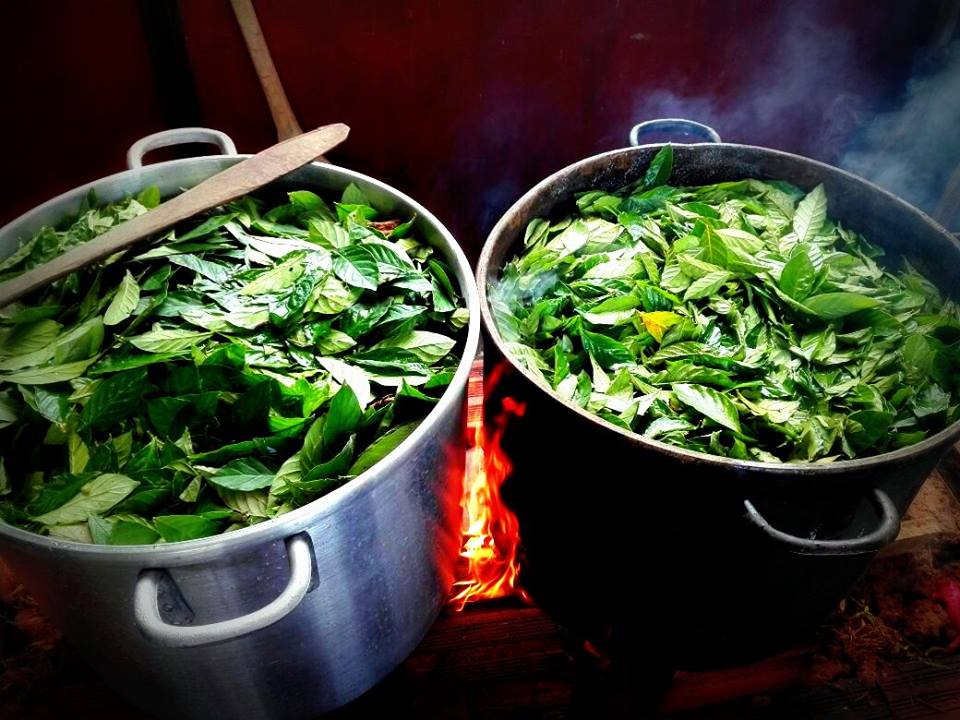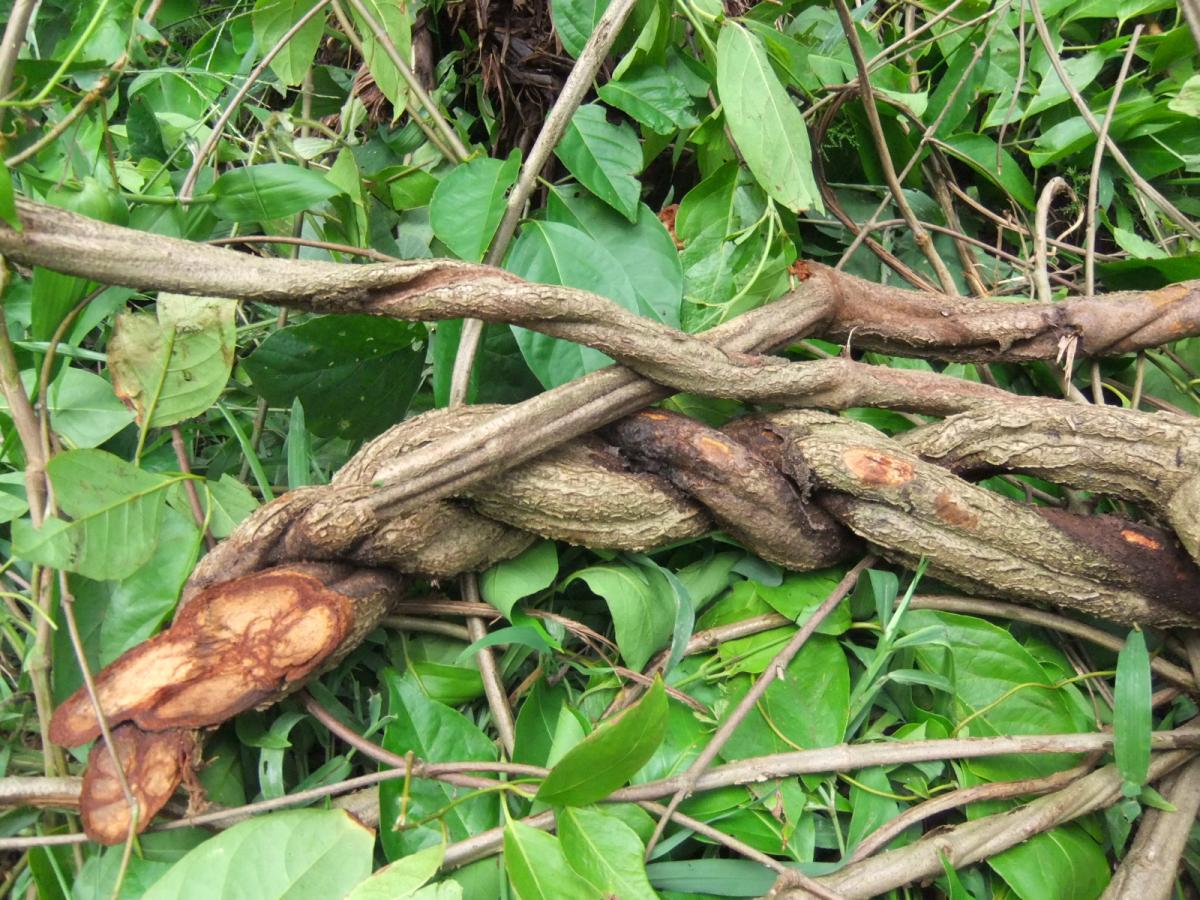Ayahuasca (Banisteriopsis caapi)
It is a large, climbing liana, with long stems, thin and rough bark, with gray or bright bright branches of little thickness.
The cortex contains alkaloids, tripamines, and derivatives of beta-carbolin: harmine, tetrahydroharmina, harmaline, harmol, among many other active ingredients.
Banisteriopsis caapi is endemic to the tropical and subtropical areas of South America, especially in Andean and Amazon regions of Colombia, Ecuador, Peru, Bolivia, Brazil and Venezuela.
The use of psychoactive plants began in ancient civilizations, as a vehicle to come into contact with the spiritual world, both in search of knowledge and healing.
This historical characteristic of communication with the energetic or spiritual world led a group of scientists, including Robert Gordon Wasson, in 1973, to propose the term “entheogen”, of Greek origin, which means “God (theos) within”, as a substitute for the previous term “hallucinogenic or psychedelic”.
Other native terms used are “master plants” or “sacred plants.”
Ayahuasca in the Quechua language means “vine of souls” (aya: dead, soul, spirit and waska: rope, liana, vine).
Ayahuasca drink
The Sacred Ayahuasca drink is obtained by cooking two species of endemic plants of the Amazon jungle: the vid banisterium caapi, which contains derivatives of betacarbolin: harmonic, harmaline and tetrahydroharmina; and the Psychotria viridis Ruíz & Pavón bush, which contains DMT (N, N-Dimethylectamine), a tripamine derivative.
To a lesser extent, other plants are used in the preparation of the drink.
In addition to Caapi Banisteriumsis, other species of the same genus are used to a lesser extent, such as longiata Banisteriumsis or Banisteriosis Lutea, among others.
On the other hand, in addition to the Psychotria viridis shrub, it is rarely replaced by other species of the same genus, such as: psychotria or Psychotria Batiskowa, among others.
McKenna (1998a) describes that in Colombia and Ecuador in addition to the genus Psychotria, another plant of the Malpighiaceae family is also used, which contains a high DMT concentration: Cabrerana dipteryys. (Ott, 1994; McKenna et al, 1998a).
Ayahuasca drink history
Botanical studies on the species used in the preparation of Ayahuasca began in 1851, when the English botanist Richard Spruce picked In 1931, it was reclassified by Morton as Banisteriosis caapi. The other species used, the Psychotria viridis bush, which was first described by Ruíz & Pavón in 1779.
This drink is also known by the names of Hoasca, Yagé, Caapi, Mihi, Natema, Pindé, Daime, Vegetable, among others; Luna mentions at least 72 tribes that use the drink and 42 different denominations. (Luna, 1986, Labate, 2004).

Ayahuasca analogues
When this psychoactive drink is performed with species other than those already mentioned and contains similar active ingredients, it is called “anahuasca” or “analogous drink of the ayahuasca”.
This term was coined by Jonathan Ott during the gestation of his mythical book “Pharmacotheon, Entraogenous drugs, its plant sources and their history”, taking a giant step in the knowledge and dissemination of these plants.
When preparing the chapter on the IMAOS and the DMT, Jonathan realized that there were countless plants around the planet containing these active ingredients, and therefore could make hundreds of psychoactive drinks analogous to the original ayahuasca of Banisterysis caapi and psychotria viridis; Sixty vegetables for each group, mathematically about 4,000 possible variants of the psychoactive drink.
Thus was born his book “Analogues of the ayahuasca, an entity of Pangea”, which was public two years later, in 1994, and with which in addition to downloading a little pages the voluminous Pharmacotheon, opened the possibility to a field of Virgin research that soon showed its enormous possibilities.
Brazilian tribes that use Ayahuasca
Many Brazilian tribes such as the Ashaninka, and especially several belonging to the Pano Linguistic trunk (Kaxinawá, Yawanawá, Jaminawá, Marubo, Katukina, among others), traditionally use ayahuasca in their rituals.
The Huni Kuin / Kaxinawá Indians use Nixi Pae, Ayahuasca made of the species of psychchotria called Kawa (Nai Kawa, P thatkawa, Batsikawa), and the species of banisterium -called Huni or Nixi Pae.
In the statement of SIã Kaxinawá, head of the T.I. Do Rio Jordão, Nus has ayahuasca:
«Ayahuasca is the science of spirit, nature, and the laws of the world. We do not take it as a joke: we drink ayahuasca to see and deal with matters of some seriousness. To prepare the drink, we go to the mountain to look for vines and leaves. When we find them, we cut the vine along with the sheet.
When we get home we leave it to continue the next day, since it is usually late.
The next day, very early in the morning, we started its preparation, which takes us all day. At seven in the afternoon we have a drink with our teammates, then sing. Each one takes everything he wants. Vid teaches us many things. ”

Taxonomy
Family: Malpightae.
Scientific name: Banisteriumsis caapi (spruce ex Griseb) Morton.
Other used names: Yagé, Bejuco Bravo; Caapi (Brazil); Mado, Mado Bidada and Rami-Wetsem (culina); Ñucñu Huasca and Shimbaya Huasca (Quechua): Kamalampi (Piro); Punga Huasca; Rambi and Shuri (Sharanahua); Ayahuasca yellow; Ayawasca, Nishi and Oni (Shipi- bo), Ayahuasca Negro, Ayahuasca Blanco; Ayahuasca sky; Shillinto Natema (Jíbaro); Golden Bejuco (Colombia); Mi-Hi (Cubeo); Amarron Huasca and Inde Huasca (Ingano); Yajé (Kofán); Shuri-Fisopa and Shuri-Oshinipa (Sharanahua), Napi; Nepe.
Leaves: It presents opposite leaves, 15 to 17 cm long and 6 to 9 cm wide with ovate-lanceolate shape and accumulated apex, its base presents two glands and has an obtuse or rounded shape.
Inflorescence: axillary, 4 flowers, 5 cm long, other times in paniculated umbels. Hermaphrodite flowers, pentameras; chalice with 8 basal glands; Corola with yellow petals, pale or reddish-bermellón pink, with ten stamens. Tricarpelar gynece, sigmoid styles.
Fruit: Samara slightly strigued, oblong, with coriacea and winding dorsal wing, 3 cm long and 0.8 cm wide.
Climate: Inhabits tropical and subtropical climates, with temperatures between 20 and 26ºC, rainfall from 1,800 to 3,500 mm/year, and altitudes of up to 1,500 meters above sea level.
Soil: Areno-archas with abundant organic matter. Biotope of natural populations: Inhabits in height soils, away from the banks, in flooded floors only with increasing high, virgin forest, under conditions of intermediate light or shadow.
Crop
It spreads through stem and root stakes, 5 cm long in horizontal position, are also used with good stem stakes about 30 cm long and 1 cm in diameter, sown in oblique position, similar to cassava .
The planting is done during the start of the rainy season, with a distancing of 3 m x 3 m. In the initial stages of its development, sporadic pruning are carried out to facilitate the harvest and control of weeds
Due to the growing expansion in the consumption of ayahuasca drink, it is necessary to develop specific culture methods of the species used for preparation outside the Amazon region, where there is currently a high extraction rate.

